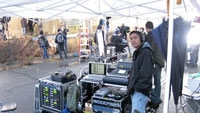For wireless producers, white space decision hits home

Gregg Kita, a longtime freelance audio system designer and mixer, is very worried about the FCC’s decision to allow unlicensed devices to operate in the spectrum used by wireless production products. He has worked on a variety of reality TV shows, where wireless microphones and untethered camcorders are a staple. Without such tools, these reality shows would not be as “unrehearsed” as they are now.
The way Kita sees it, he’s often asked to mic a cast of up to 20 people who are roaming around a house, then add wireless cameras and producers on IFB. In some cases, that could mean having to coordinate 60 frequencies simultaneously. If one of the aforementioned devices, like a wireless modem, is being used next door, he might loose his entire production or maybe one or two sources. In a business where time is money, that’s not acceptable.
“This issue has really hit home for us in the production community,” Kita said. He just finished work on the TV Land channel’s new “She’s Got The Look” show and has completed projects for the new “Secrets of Magic” (MyNetworkTV), “Starmaker” (MTV) and others for VH1. “I’m very concerned about these devices, but we’ll have to wait and see the real impact when consumers start using them. “I’ve heard all of the arguments for and against using the same spectrum as we do, but in the end, it all comes down to what’s happening that day on the set. That’s really all I care about.”
Through his audio and video production company, RGEAR, he uses Aviom’s Pro16 and Pro64 audio distribution products. This helps ease setup and breakdown of locations, which often take him indoors one day and outside on a beach the next. With its internal signal converters, the Aviom unit is moved around the set on a small and highly mobile audio cart and allows Kita to use small Cat 6 cabling between his cart and the audio mixing board, instead of the larger (and harder to hide) audio cabling typically used. This saves him time and enables him to create runs of up to 500ft without signal degradation.
Using Cat 6 cable is also much cheaper than traditional audio cabling, so Kita and his crew can cut it to different lengths as needed, and, because it’s smaller in size, the wires are easy to hide inside plants and around furniture when inconspicuously capturing audio.
In a typical setup inside a home, Kita sill places the Aviom units in the garage and throughout the house. Mics are wired to the Aviom boxes upstairs, and Cat 5 cables carry the signals to the “production area” in the garage. The Aviom boxes convert the analog signals from the mics to digital, so they can be sent over the Cat 6 cables. An I/O module made by Aviom then converts the signal back to analog for mixing on the Yamaha board.
For his microphones, Kita uses Sennheiser SK5212 wireless transmitters and EM3532 receivers. There are also EK3241 receivers mounted to audio mixers that move around with the cameras on set. They also use Yamaha DM1000 mixing boards. A separate mixer is often used for each camera. He records audio to a Macintosh computer and external hard drive. He captured 80GB of audio data per day on the VH1 show “Rock of Love.”
The professional video industry's #1 source for news, trends and product and tech information. Sign up below.
In its ruling on the use of unlicensed wireless devices, the FCC has tried to protect wireless microphones in a variety of ways. The locations where wireless microphones are used, such as sports and entertainment venues, can be registered in a database and will remain protected. In addition, Channels 2–20 will be restricted to fixed devices. The commission also said many of these channels will remain available for wireless microphones that operate on an itinerant basis, which describes what Kita and his team do.
In addition, in 13 major markets where certain channels between 14 and 20 are used for land mobile operations, the commission will leave two channels between 21 and 51 free of new unlicensed devices and available for wireless microphones. The FCC has required that wireless devices include the ability to listen to the airwaves to sense wireless microphones as an additional measure of protection.
All of this is not calming Kita’s nerves; he’s taking a wait-and-see attitude.
“I can understand why broadcasters are upset, but this whole issue is going to affect our business the most, because we rely so heavily on wireless spectrum,” Kita said. “Sometimes we can use scouts and do a frequency check, but most times on a reality show set we don’t have that luxury. We have to move in and out of locations quickly, so we use the most available frequency. With these new devices operating, we might not be able to find a frequency, which will limit what we do considerably.”
